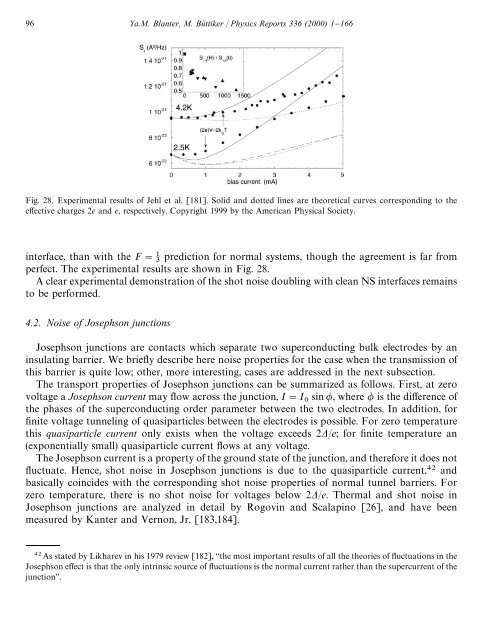shot noise in mesoscopic conductors - Low Temperature Laboratory
shot noise in mesoscopic conductors - Low Temperature Laboratory
shot noise in mesoscopic conductors - Low Temperature Laboratory
You also want an ePaper? Increase the reach of your titles
YUMPU automatically turns print PDFs into web optimized ePapers that Google loves.
96 Ya.M. Blanter, M. Bu( ttiker / Physics Reports 336 (2000) 1}166<br />
Fig. 28. Experimental results of Jehl et al. [181]. Solid and dotted l<strong>in</strong>es are theoretical curves correspond<strong>in</strong>g to the<br />
e!ective charges 2e and e, respectively. Copyright 1999 by the American Physical Society.<br />
<strong>in</strong>terface, than with the F" prediction for normal systems, though the agreement is far from<br />
perfect. The experimental results are shown <strong>in</strong> Fig. 28.<br />
A clear experimental demonstration of the <strong>shot</strong> <strong>noise</strong> doubl<strong>in</strong>g with clean NS <strong>in</strong>terfaces rema<strong>in</strong>s<br />
to be performed.<br />
4.2. Noise of Josephson junctions<br />
Josephson junctions are contacts which separate two superconduct<strong>in</strong>g bulk electrodes by an<br />
<strong>in</strong>sulat<strong>in</strong>g barrier. We brie#y describe here <strong>noise</strong> properties for the case when the transmission of<br />
this barrier is quite low; other, more <strong>in</strong>terest<strong>in</strong>g, cases are addressed <strong>in</strong> the next subsection.<br />
The transport properties of Josephson junctions can be summarized as follows. First, at zero<br />
voltage a Josephson current may #ow across the junction, I"I s<strong>in</strong> , where is the di!erence of<br />
the phases of the superconduct<strong>in</strong>g order parameter between the two electrodes. In addition, for<br />
"nite voltage tunnel<strong>in</strong>g of quasiparticles between the electrodes is possible. For zero temperature<br />
this quasiparticle current only exists when the voltage exceeds 2/e; for "nite temperature an<br />
(exponentially small) quasiparticle current #ows at any voltage.<br />
The Josephson current is a property of the ground state of the junction, and therefore it does not<br />
#uctuate. Hence, <strong>shot</strong> <strong>noise</strong> <strong>in</strong> Josephson junctions is due to the quasiparticle current, and<br />
basically co<strong>in</strong>cides with the correspond<strong>in</strong>g <strong>shot</strong> <strong>noise</strong> properties of normal tunnel barriers. For<br />
zero temperature, there is no <strong>shot</strong> <strong>noise</strong> for voltages below 2/e. Thermal and <strong>shot</strong> <strong>noise</strong> <strong>in</strong><br />
Josephson junctions are analyzed <strong>in</strong> detail by Rogov<strong>in</strong> and Scalap<strong>in</strong>o [26], and have been<br />
measured by Kanter and Vernon, Jr. [183,184].<br />
As stated by Likharev <strong>in</strong> his 1979 review [182], `the most important results of all the theories of #uctuations <strong>in</strong> the<br />
Josephson e!ect is that the only <strong>in</strong>tr<strong>in</strong>sic source of #uctuations is the normal current rather than the supercurrent of the<br />
junctiona.
















